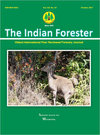Systematic Account on Two Major Soil Macrofauna, Scorpions (Arachnida: Scorpiones) and Centipedes (Chilopoda: Scolopendromorpha) of Chinnar Wildlife Sanctuary, Kerala, India
DOI:
https://doi.org/10.36808/if/2017/v143i10/119358Keywords:
Chinnar WLS, Rain Shadow Forest, Scorpions, Centipedes, Western Ghats.Abstract
The present study highlighted the diversity of two important soil macro fauna viz., Centipedes (Chilopoda: Scolopendromorpha) and Scorpions (Arachnida: Scorpiones) from Chinnar Wildlife Sanctuary, Idukki District, Kerala, the Southern Western Ghats. Being a rain shadow area, the study area possesses a unique faunal component. We reported 6 species of Scorpions and 7 species of Scolopendrid centipedes from the study area. The study included the first report of the centipede species Cormocephalus westwoodi westwoodi (Newport) from Kerala and the listing out of Cormocephalus (Dekanonyx) nigrificatus Verhoeff (endemic to Southern India) and Otostigmus gravely (Jangi and Dass) (Endemic to Kerala) and Rhysida lithobiodes trispinosus Jangi and Dass (endemic to Deccan plateau).References
Aswathi K., Sureshan P.M. and Lourenco W.R. (2015). A new scorpion of the genus ButhoscorpioWerner, 1936 (Scorpiones: Buthidae) From Kerala, India, Taprobanica,7 (4): 213-218.
Attems C. (1928). Neue Scolopendriden der Museen Wien und Hamburg. Zoologische Anzeiger, Leipzig, 78 (11/12): 279-309.
Attems C. (1930). Myriapoda 2. Scolopendromorpha. In: Das Tierreich, Berlin (Schulze, F. E. & Kükenthal, W. ed.),Walter de Gruyter, 54: 1–308.
Bastawade D.B., Jadhav S.S and Sharma R.M. (2012). Scorpionida. Zoological Survey in India, 4 (6):1-16.
Bonato L., Edgecombee G., Lewis J.G.E., Minelli A., Pereira L.A., Shelley R.M. and Zapparoli, M. (2010).A common terminology for the external anatomy of centipede (Chilopoda). Zookeys,69:17-51.
Bucherl W. (1946). Novidades systematics na ordem Scolopendromorpha. Mem.Inst. Butantan, 19: 135- 157.
Jangi B.S. and Dass C.M.S. (1984). Scolopendridae of Deccan. J. Scientific and Industrial Research ,43 (2): 27-54.
Joshi J. and Edgecombe G.D. (2013). Revision of the scolopendrid centipede Digitipes Attems, 1930 from India (Chilopoda: Scolopendromorpha): reconciling molecular and morphological estimates of species diversity. Zootaxa, 3626 (1). 99-145.
Khanna V. (1994). Chilopoda: Some ecological observations on the centipede Cormocephalus Pocock, with comments on “sexual dimorphism†in the species and on the status of Cormocephalus pseudonudipes Jangi and Dass, 1984. In: Fauna of Conservation area Series 5: Fauna of Rajaji National Park, Kolkata: Zool. Surv. India, 237-243.
KovarÃk F. (1999). Hemibuthus kraepelini, a junior synonym of Hottentotta rugiscutis (Scorpiones: Buthidae). Acta Societatis Zoologicae Bohemicae, 63: 291–293.
KovarÃk F. (2004). A Review of the Genus Heterometrus Ehrenberg, 1828, with Descriptions of Seven New Species (Scorpiones. Scorpionidae), Euscorpius, 15:1-60.
Kraepelin K. (1903). Revision der Scolopendriden (Scolopendromorpha). Mitt. Mus.,Hamburg, 20: 1-276.
Lawrence R.F. (1955). Chilopoda. Results of the Lund University Expedition in 1950-1951. South African Animal Life, 2: 4-56.
Lewis J.G.E. (2001). The scolopendrid centipedes in the collections of the National Museum of Natural History in Sofia (Chilopoda: Scolopendromorpha: Scolopendridae). Historia Naturalis Bulgarica, 13: 5-51.
Minelli A., Bonato L. and Dioguardi R. (2006 onwards). Chilobase:a web resource for Chilopoda taxonomy. Publicly searchable at http://chilobase.bio. unipd.it
Newport G. (1844). A list of the species of Myriapoda, Order Chilopoda, contained in the cabinets of the British Museum with synoptic descriptions of forty-seven new species. Annals and Magazines of Natural History, 13: 94-101.
Pocock R.I. (1891). Notes on the synonymy of some species of Scolopendridae with descriptions of new genera and species of the group. Ann. nat. Hist., 6, 7: 51-68 and 221-231.
Pocock R.I. (1893). Notes on the classification of Scorpions, followed by some Observations upon Synonymy, with Descriptions of new Genera and Species. Ann. Mag. Natur. Hist., 6: 303-331.
Pocock R.I. (1897). Descriptions of some new species of scorpions from India. J. Bombay Natural History Society, 11:102-117.
Pocock R.I. (1900). Arachnida. The Fauna of British India, including Ceylon and Burma. Published under the authority of the Secretary of State for India in Council. London: W.T. blandford, xii, 279 pp.
Porat C.O. von. (1871). Myriopoda Africae australis in Museo Regio Holmiensi asservata recensuit. Pars I. Chilopoda . Öfversigt af Kongliga Vetenskaps- Akademiens Förhandlingar, 28: 1135-1167.
Schileyko A. A. and Stagl V. (2004). The collection of scolopendromorph centipedes(Chilopoda) in the Natural History Museum in Vienna: a critical re-evaluation of formertaxonomic identifications. Annals of Natural hisory. Museum Wien, Series B, 105B:67-137.
Simon E. (1884). Arachnidesrecueillisen Birmanie par M. le Chevalier J. B. Comottoetappartenent au Musée Civiqued'Histoire Naturelle de Génes. Annali del Museo Civico di StoriaNaturale di Genova, 20: 1–48.
Stahnke H.L. (1970). Scorpion nomenclature and mensuration. – Entomological News, 81: 297-316. Philadelphia.
Sureshan P.M., Khanna V. and Radhakrishnan C. (2006). Additional distributional records of scolopendrid centipedes (Chilopoda: Scolopendromorpha) from Kerala. Zoos'. print, 21(6): 2285-2291.
Sureshan P.M. and Yadav B.E. (2008). Chilopoda: Scolopendromorpha. In: Fauna of Goa, State Fauna Series. Kolkata: Zool. Surv. India, 16:7377.
Tikader B.K. and Bastawade D.B. (1983). Scorpions (Scorpionida: Arachnida). In: The Fauna of India, Vol. 3 (Edited by the Director). Calcutta: Zoological Survey of India, 671pp.
Verhoeff K.W. (1937). Zwei neue Myriapoden -Gattungen aus Indien und ihre stellung. Zool. Anz., 120: 81-89.
Yadav B.E. (2009). Chilopoda: Scolopendromorpha. In: Fauna of Bhimasankar Wildlife Sanctuary, Conservation Area Series, Kolkata. Zool. Surv. India, 42: 1-12.
Downloads
Downloads
Published
How to Cite
Issue
Section
License
Unless otherwise stated, copyright or similar rights in all materials presented on the site, including graphical images, are owned by Indian Forester.





